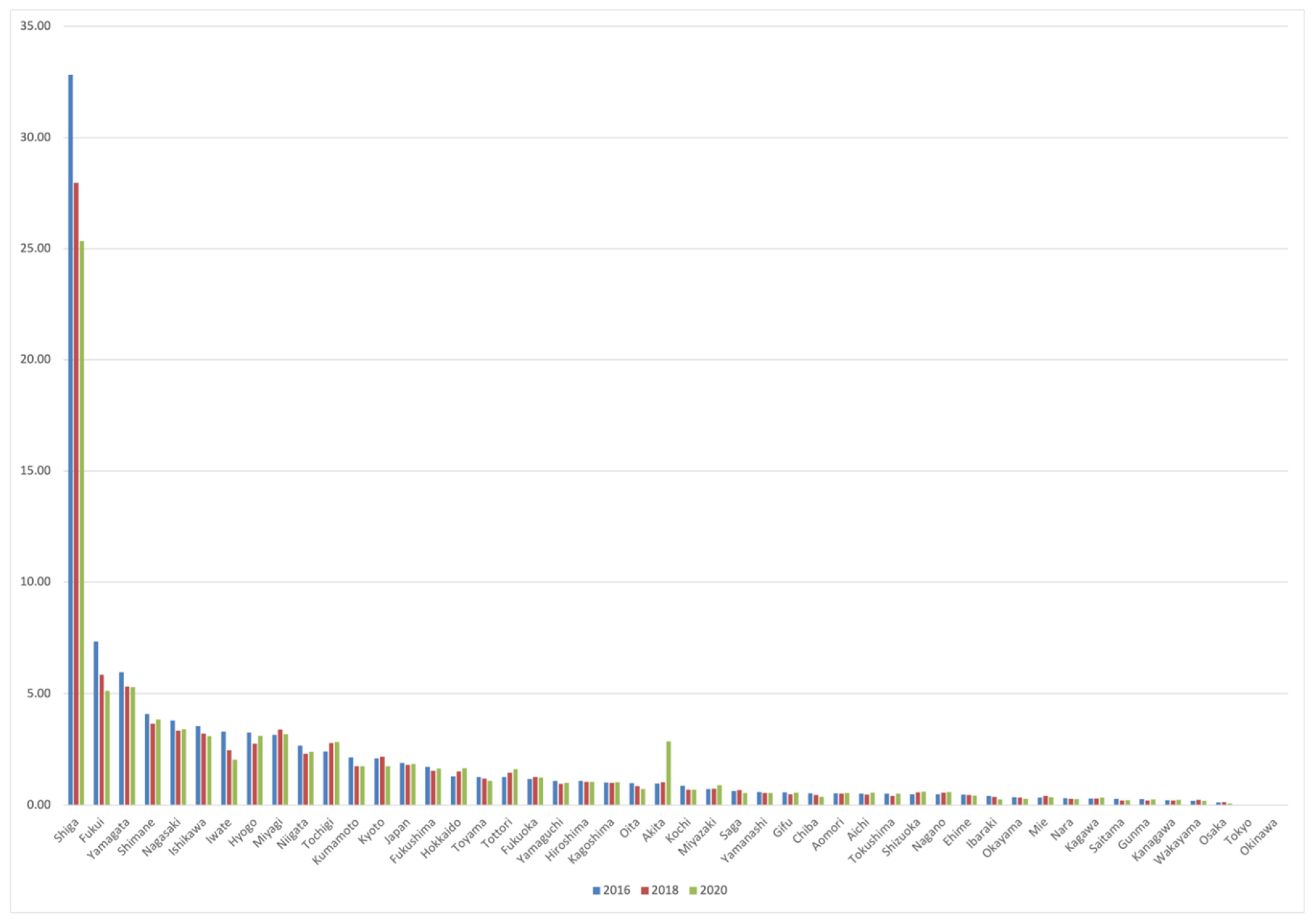Japan aims to be carbon-neutral by 2050 by targeting various sectors including agriculture. One of the main strategies in this sector to mitigate climate change effects is environmental conservation agriculture (ECA); however, ECA utilization remains low in most of Japan’s prefectures to this date. Japan has been active in promoting biodiversity conservation and sustainable agriculture, which is why it currently has a total of 11 Globally Important Agricultural Heritage Systems (GIAHS) designated by FAO. Japan has been proactive in preserving endangered species, such as butterflies vascular plants, and birds
- environmental conservation agriculture
- biodiversity conservation
- Fujioka
- yaritanago
- environmental concern
- sustainable agriculture
- climate change
1. Introduction


2. Sustainable Agriculture and Biodiversity Conservation in Japan
3. Factors Affecting Farmers’ Adoption of Environmental Conservation Agriculture Methods
This entry is adapted from the peer-reviewed paper 10.3390/su14095296
References
- Beddington, J.R.; Asaduzzaman, M.; Clark, M.E.; Bremauntz, A.F.; Guillou, M.D.; Howlett, D.J.B.; Jahn, M.M.; Lin, E.; Mamo, T.; Negra, C.; et al. What Next for Agriculture After Durban? Science 2012, 335, 289–290.
- Foley, J.A.; DeFries, R.; Asner, G.P.; Barford, C.; Bonan, G.; Carpenter, S.R.; Chapin, F.S.; Coe, M.T.; Daily, G.C.; Gibbs, H.K.; et al. Global consequences of land use. Science 2005, 309, 570–574.
- Golcher, C.S.; Visseren-Hamakers, I.J. Framing and integration in the global forest, agriculture and climate change nexus. Environ. Plan. C-Politics Space 2018, 36, 1415–1436.
- Intergovernmental Panel on Climate Change (IPCC) (Ed.) Summary for Policymakers; IPCC: Geneva, Switzerland, 2020.
- Campbell, B.M.; Beare, D.J.; Bennett, E.M.; Hall-Spencer, J.M.; Ingram, J.S.I.; Jaramillo, F.; Ortiz, R.; Ramankutty, N.; Sayer, J.A.; Shindell, D. Agriculture production as a major driver of the Earth system exceeding planetary boundaries. Ecol. Soc. 2017, 22, 8.
- Bhattacharyya, P.; Pathak, H.; Pal, S. Climate Smart Agriculture: Concepts, Challenges, and Opportunities; Green Energy and Technology; Springer: Berlin/Heidelberg, Germany, 2020.
- Maharjan, K.; Joshi, N. Climate Change, Agriculture and Rural Livelihoods in Developing Countries; Springer: Tokyo, Japan, 2013.
- Ministry of Agriculture, Forestry and Fisheries (MAFF). Summary of the Annual Report on Food, Agriculture and Rural Areas in Japan; Ministry of Agriculture, Forestry and Fisheries (MAFF): Tokyo, Japan, 2021.
- Food and Agriculture Organization of the United Nations (FAO). Conservation Agriculture: Training Guide for Extension Agents and Farmers in Eastern Europe and Central Asia; Food and Agriculture Organization of the United Nations (FAO): Rome, Italy, 2019.
- Ministry of Agriculture, Forestry and Fisheries (MAFF). Basic Concept of Environmental Conservation Type Agriculture Promotion; Ministry of Agriculture, Forestry and Fisheries (MAFF): Tokyo, Japan, 1994.
- Ministry of Agriculture, Forestry and Fisheries (MAFF). Summary of the Annual Report on Food, Agriculture and Rural Areas in Japan; Ministry of Agriculture, Forestry and Fisheries (MAFF): Tokyo, Japan, 2020.
- Johnson, J.M.F.; Franzluebbers, A.J.; Weyers, S.L.; Reicosky, D.C. Agricultural opportunities to mitigate greenhouse gas emissions. Environ. Pollut. 2007, 150, 107–124.
- Adegbeye, M.J.; Reddy, P.R.K.; Obaisi, A.I.; Elghandour, M.; Oyebamiji, K.J.; Salem, A.Z.M.; Morakinyo-Fasipe, O.T.; Cipriano-Salazar, M.; Camacho-Diaz, L.M. Sustainable agriculture options for production, greenhouse gasses and pollution alleviation, and nutrient recycling in emerging and transitional nations—An overview. J. Clean. Prod. 2020, 242, 118319.
- Mona, S.; Malyan, S.K.; Saini, N.; Deepak, B.; Pugazhendhi, A.; Kumar, S.S. Towards sustainable agriculture with carbon sequestration, and greenhouse gas mitigation using algal biochar. Chemosphere 2021, 275, 129856.
- Maharjan, K.L.; Gonzalvo, C.M.; Aala, W.F. Leveraging Japanese Sado Island Farmers’ GIAHS Inclusivity by Understanding Their Perceived Involvement. Sustainability 2021, 13, 1312.
- Miyake, Y.; Kimoto, S.; Uchiyama, Y.; Kohsaka, R. Income Change and Inter-Farmer Relations through Conservation Agriculture in Ishikawa Prefecture, Japan: Empirical Analysis of Economic and Behavioral Factors. Land 2022, 11, 245.
- Takeshi, F. Conservation agriculture adoption and its impact: Evidence from Shiga prefecture, Japan. J. Int. Econ. Stud. Hosei Univ. 2015, 29, 35–48.
- Nakamura, Y. Conservation of butterflies in Japan: Status, actions and strategy. J. Insect Conserv. 2011, 15, 5–22.
- Iwatsuki, K. Endangered vascular plants in Japan—Present status and a proposal for conservation. Proc. Jpn. Acad. Ser. B-Phys. Biol. Sci. 2008, 84, 275–286.
- Onuma, M. The Present Status of Available Genetic Information for Avian Species Distributing in Japan and on the List of “Nationally Endangered Species of Wild Fauna and Flora”. J. Poult. Sci. 2015, 52, 167–175.
- Hata, H.; Uemura, Y.; Ouchi, K.; Matsuba, H. Hybridization between an endangered freshwater fish and an introduced congeneric species and consequent genetic introgression. PLoS ONE 2019, 14, e0212452.
- Terui, A.; Matsuzaki, S.S.; Kodama, K.; Tada, M.; Washitani, I. Factors affecting the local occurrence of the near-threatened bitterling (Tanakia lanceolata) in agricultural canal networks: Strong attachment to its potential host mussels. Hydrobiologia 2011, 675, 19–28.
- Kakekawa, Y. Agriculture and Bioprotection: A Reflection on Land Consolidation Project Site in Fujioka City, Gunma Prefecture. In Climate resilient Environmental Conservation Agriculture: Focusing on Biodiversity Conservating Japanese Environmental Conservation Agriculture Case Studies; Maharjan, K.L., Ed.; Environmental Conservation Agriculture Study Group, Hiroshima University: Hiroshima, Japan, 2022. (In Japanese)
- Koohafkan, P.; Altieri, M. Globally Important Agricultural Heritage Systems—A Legacy for the Future; Food and Agriculture Organization of the United Nations: Rome, Itlay, 2010.
- Kato, M. Column: Endangered Species in Japan: Ex Situ Conservation Approaches and Reintroduction in the Wild. In Social-Ecological Restoration in Paddy-Dominated Landscapes; Usio, N., Miyashita, T., Iwasa, Y., Eds.; Ecological Research Monographs; Springer: Tokyo, Japan, 2014.
- Zukowska, G.; Myszura, M.; Baran, S.; Wesolowska, S.; Pawlowska, M.; Dobrowolski, L. Agriculture vs. Alleviating the Climate Change. Probl. Ekorozw. 2016, 11, 67–74.
- Dessart, F.J.; Barreiro-Hurle, J.; van Bavel, R. Behavioural factors affecting the adoption of sustainable farming practices: A policy-oriented review. Eur. Rev. Agric. Econ. 2019, 46, 417–471.
- Mozzato, D.; Gatto, P.; Defrancesco, E.; Bortolini, L.; Pirotti, F.; Pisani, E.; Sartori, L. The Role of Factors Affecting the Adoption of Environmentally Friendly Farming Practices: Can Geographical Context and Time Explain the Differences Emerging from Literature? Sustainability 2018, 10, 3101.
- Barlett, P. Agricultural Decision Making: Anthropological Contributions to Rural Development; Academic Press, Inc.: Orlando, FL, USA, 1980.
